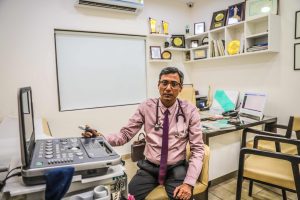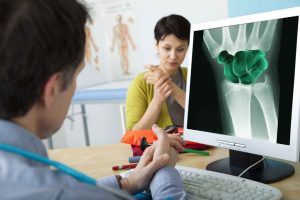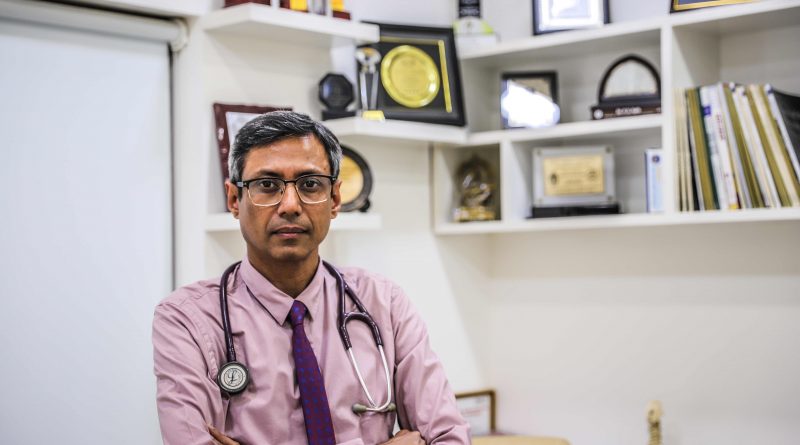Face thier Challenge with Confidence

Dr Prasan Deep Rath, MD, FACR, FNIMS, GCPR(AUS, Diploma MSK USG (UCAM SPAIN), Associate Director and Head of Department
Rheumatology, Max Super Specialty Hospital Saket ,Smart ,Panchsheel, New Delhi is a leading Rheumatologist treating adult as well
pediatric Rheuatology. Also has attended various workshops and courses related to rheumatology worldwide and keeps updated to newer
upcoming in the field of rheumatology……
By Amresh K Tiwary
He is treating major diseases like Ankylosing Spondylitis, Gout, Juvenile Arthritis, Osteoarthritis, Juvenile Arthritis, Psoriatic Arthritis, Reactive Arthritis, Rheumatoid Arthritis, Systemic Lupus Erythematosus, Back pains and nerve root diseases, Osteoporosis. He has vast knowledge and experience build up during his long career. He has achieved outstanding professional and clinical skills resulting in highly successful results in his clinical endeavours.
Dr P D Rath is well known as one of the top Rheumatologist in India who has helped thousands of patients handle their Rheumatism and face their challenge with confidence. He is also running Rheumatology and Pain Clinic in Sector 37, Noida..
According to Dr P D Rath, Rheumatic disease refers to any type of arthritis, certain autoimmune diseases, musculoskeletal pain disorders, and osteoporosis. There are over 100 conditions that range from common conditions like osteoarthritis, tendonitis, and gout to complex problems such as rheumatoid arthritis, lupus, vasculitis, and ankylosing spondylitis. Arthritis can affect anyone of any age, including children, though women tend to be affected more than men. Pain can vary from mild to disabling, but all symptoms must be evaluated as they can indicate far more serious underlying problems.
 Many types of rheumatic diseases are not easily identified in the early stages. Rheumatologists are specially trained to do the detective work necessary to discover the cause of swelling and pain. It is important to determine a correct diagnosis early so that appropriate treatment can begin. Some musculoskeletal disorders respond best to the treatment in the early stages of the disease.
Many types of rheumatic diseases are not easily identified in the early stages. Rheumatologists are specially trained to do the detective work necessary to discover the cause of swelling and pain. It is important to determine a correct diagnosis early so that appropriate treatment can begin. Some musculoskeletal disorders respond best to the treatment in the early stages of the disease.
Today, state-of-the-art treatments are available for the majority of the rheumatic conditions. Cutting edge technology has given us new drugs which can block the interaction of certain proteins with cells, dramatically reducing inflammation and swelling.
An autoimmune disorder: Risk cause of many
Some years ago, an autoimmune disorder was not a term that people in India were largely familiar with. But in recent times, more and more people – especially women – are being diagnosed with it.
“In the past, autoimmune diseases weren’t given adequate attention mainly for two reasons. First, many thought that, unlike in the West, autoimmune diseases were not a big problem in India. Second, they were ignored because they were considered to be untreatable,” says, Dr P D Rath
It takes a while for the disorder to be identified because patients first visit doctors to treat its symptoms like acute joint pains or skin problems. When a 35 year old Deepti Sharma’s skin disease persisted, her doctor recommended that she consult a rheumatologist. Five years ago, the specialist confirmed that she was suffering from psoriatic arthritis, a disease that not only leaves patches of the skin inflamed but also attacks the joints in the body, making them swollen and stiff. Since then, Deepti has been on medication, which she cannot afford to skip even for a day without risking a flare-up in her condition.
Who suffered from a chronic autoimmune disease called systemic lupus erythematosus, or simply lupus.
The disease takes root when the body’s immune cells, which are supposed to fight invading germs and toxins, turn against one’s own cells. The disorder, for which there is no cure so far, spares no organs in the body and more often than not affects more than one organ.
While no data exist on how many Indians suffer from autoimmune diseases, a global estimate shows that nearly 700 million people – that is, nearly one-tenth of the global population – suffer from some kind of an autoimmune disease, in stages ranging from mild and moderate to severe.
Yet so little is known about it that it almost severely incapacitated Rajiv Deshmukh a 32-year-old manager at a Nagpur based firm, had been suffering from a low back pain for a while. When the rest and medicines prescribed by his doctor actually aggravated his condition, he went for further tests which showed that his back pain was because of an autoimmune condition called ankylosing spondylitis.
According to P.D. Rath, his condition could have worsened and he could have suffered a fused disc if he continued with the bed rest. Ankylosing spondylitis requires not bed rest but regular physical activity.
Among the hundreds of autoimmune diseases that exist, the two most prevalent types among Indians are rheumatoid (in women) and ankylosing (in men). Limited studies showed that close to one per cent of women suffered from rheumatoid and one per cent of men from ankylosing disorders. The third most common type is lupus. Nine out of 10 lupus patients are women.
It’s not known what causes the disease. In many cases, it may be genetic. Since women are mostly affected, scientists think hormones too play a role.While no hard data are available to indicate if the problem is increasing, rheumatologists say that more and more patients are turning up at their clinics.
Dr P D Rath sees 50-60 patients every day nowadays, compared with 15-20 patients some 10 years ago. He says, “The rise in numbers could be because of increasing awareness. It could also be because of an increase in the number of rheumatology clinics and better diagnostic tests available today.”
Dr Rath, however, thinks there are reasons to believe the incidence is more prevalent today than before. As the incidence of infectious diseases decreases, at least among some sections of the population, there is a greater chance that autoimmune diseases will go up, he believes. He points to a study in the UK which showed an increase in IBD among Asians in the UK as compared with Indians in India.Though there is no cure for the disease, the problems can be stemmed with medicine.
For most patients, conventional drugs – which can cost Rs 300 to Rs 4,000 a month, depending on the medicine and the disorder – can work. One out of five patients, however, requires drugs that can cost a lot more, says Dr Rath. This is when the disease aggravates and patients fail to respond to conventional to treat cancer.
Internationally, efforts are on to develop better drugs. But beyond medicines, there is need for awareness. Most patients tire more easily than their healthy counterparts and they need brief spells of rest in their work hours. Even immediate family members think that they would be all right as they are taking medicines regularly. This is a wrong assumption.Unlike in the West, no support groups are available for those who suffer from autoimmune diseases in India. Perhaps, in the times to come, and as awareness about the disease spreads, people will extend a helping hand to others
Arthritis: A chronic pain condition
If you are experiencing symptoms like aching joints, difficulty in dressing or combing hair, gripping objects, sitting or bending over, joint being warm to the touch, morning stiffness for less than an hour, pain when walking, and stiffness after resting, swelling of joint and loss of motion in a joint, you must consult a Rheumatologist. You might have arthritis because these are its common symptoms.
In common parlance, Arthritis is a condition that affects more than 10% of the adult population. There are more than 100 different types of arthritis. The false notion that all forms of arthritis are alike has led people to try treatments that have little effect on their arthritis symptoms. Since each type of arthritis is different, each type calls for a different approach to treatment. That means an accurate diagnosis is crucial for anyone who has arthritis.
There are two major types of arthritis — osteoarthritis, which is the “wear and tear” arthritis, and rheumatoid arthritis, an inflammatory type of arthritis that happens when the body’s immune system does not work properly. Gout, which is caused by crystals that collect in the joints, is another common type of arthritis. Psoriatic arthritis, lupus, and septic arthritis are other types.
Osteoarthritis is also called degenerative joint disease or degenerative arthritis. It is the most common chronic joint condition. Osteoarthritis results from overuse of joints but most commonly it is an aging phenomenon. It can be the consequence of demanding sports where joints may be injured or obesity, which places increased load on weight bearing joints. Osteoarthritis in the hands is frequently inherited and often happens in middle-aged women. Osteoarthritis is most common in joints that bear weight — such as the knees, hips, feet, and spine. It often comes on gradually over months or even years. Except for the pain in the affected joint, you usually do not feel sick, and there is no unusual fatigue or tiredness as there is with some other types of arthritis.
With osteoarthritis, the cartilage gradually breaks down. Cartilage is a slippery material that covers the ends of bones and serves as the body’s shock absorber. As more damage occurs, the cartilage starts to wear away, or it doesn’t work as well as it once did to cushion the joint. As an example, the extra stress on knees from being overweight can cause damage to knee cartilage. That, in turn, causes the cartilage to wear out faster than normal.
As the cartilage becomes worn, cushioning effect of the joint is lost. The result is pain when the joint is moved. Along with the pain, sometimes you may hear a grating sound when the roughened cartilage on the surface of the bones rubs together. Painful spurs or bumps may appear on the end of the bones, especially on the fingers and feet. While not a major symptom of osteoarthritis, inflammation may occur in the joint lining as a response to the breakdown of cartilage.
Rheumatoid arthritis is the most common type of inflammatory arthritis. About 75% of those affected are women. In fact, between 1% and 3% of women are likely to develop rheumatoid arthritis in their lifetime.
Rheumatoid arthritis is an autoimmune disease. That means that the immune system attacks parts of the body. The joints are the main areas affected by this malfunction in the immune system. Over time, chronic inflammation can lead to severe joint damage and deformities. About one out of every five people who have rheumatoid arthritis develop lumps on their skin called rheumatoid nodules. These often develop over joint areas that receive pressure, such as over knuckles, elbows, or heels.
Symptoms of rheumatoid arthritis can come on gradually or start suddenly. Unlike osteoarthritis, symptoms of rheumatoid arthritis are often more severe, causing pain, fatigue, loss of appetite, stiffness.
With rheumatoid arthritis, you may feel pain and stiffness and experience swelling in your hands, wrists, elbows, shoulders, knees, ankles, feet, jaw, and neck. Sometimes the pain occurs in one body part. But more commonly, rheumatoid arthritis pain occurs in combinations of several joints such as in the hands, knees, and feet.
With rheumatoid arthritis, the joints tend to be involved in a symmetrical pattern. That is, if the knuckles on the left hand are inflamed, the knuckles on the right hand will also be inflamed. After a period of time, more of your joints may gradually become involved with pain and swelling and may feel warm to the touch. The joint swelling is persistent and interferes with activities. For example, it can interfere with opening a jar, driving, working, and walking — the very activities that allow us to function in our daily lives.
Arthritis is a chronic pain condition. Pain relief is the goal of treatment and disease management strategies. The treatment is aimed at controlling symptoms and slowing progression of the disease. In other words, medication and other arthritis treatments may have analgesic (pain-relieving) effects, anti-inflammatory effects, and disease-modifying effects. The goal is to feel better, maintain a good quality of life, and slow down and even stop joint destruction. People with certain types of arthritis, such as rheumatoid arthritis may achieve remission with treatment.
Researchers are continually developing new and better treatments for arthritis. Take an interest in learning more about what is in the pipeline. You can discuss potential new treatments with your doctor, as you decide together whether a new treatment will be an appropriate option for you or if it would be better to stay the course with your current treatment.
Among the most popular supplements used by people with osteoarthritis are glucosamine and chondroitin. In those with moderate to severe knee pain from osteoarthritis, the combination of glucosamine and chondroitin sulfate may be effective in providing are helpful in everyone.
Potent anti-inflammatory agents like Visco supplements can be injected to reduce pain and inflammation.
The stem cell/Platelet Rich Plasma (PRP) therapyinvolves injecting platelets from the patient’s own blood to rebuild a damaged tendon or cartilage. It has been successful in not only relieving the pain, but also in jumpstarting the healing process. The patient’s blood is drawn and placed in a centrifuge for 15 minutes to separate out the platelets. The platelet-rich plasma is then injected into the damaged portion of the tendon or cartilage.
The surgery procedures are used as a last resort. Like all other surgeries, these surgeries have their own issues like associated risks and high hospitalization and recovery times. However, the success rate for surgeries is limited to 60-70 percent.
The symptoms and effects of RA may come and go. A period of high disease activity (increases in inflammation and other symptoms) is called a flare. A flare can last for days or months. Ongoing high levels of inflammation can cause problems throughout the body. Small lumps under the skin over bony areas. Inflammation and scarring can result in shortness of breath in lungs and inflammation of blood vessels that can lead to damage in the nerves, skin and other organs.
Education & Training:
M.B.B.S from SCB Medical College (MCI Recognized) Utkal University, Orissa, India
MD (Internal Medicine) – Best Post Graduate , SCB Medical College (MCI Recognized), Utkal University, Orissa, India
Fellowship in Rheumatology, Dept of Rheumatology Nizam’s Institute of Medical Sciences Punjagutta Hyderabad
Graduate Certificate in PAEDIATRIC RHEUMATOLOGY University of Western Australia
EULAR certified MSK Ultrasonography (Completed EULAR competency assessment)
DIPLOMA IN MSK USG UCAM SPAIN
Awards Information:
Recipient of the prestigious ”DRA YOUNG INVESTIGATOR AWARD 2005“ for best paper at the Annual Rheumatology Conference in Hyderabad in Dec 2005
Member Organizing Committee of IRACON Khajurao 2007
CHIKITSA RATAN AWARD for excellence in Rheumatology given by IMA South Delhi Branch
IRACON 2009 JAIPUR(SPEAKER-TOPIC REACTIVE ARTHRITIS)
IRACON 2010 BHUBANESHWAR(SPEAKER -TOPIC SPONDYLOARTHRITIS)
IRACON 2011 CMC VELLORE(CHAIRPERSON)
IRACON 2012 (SPEAKER-TOPIC ULTRASOUND GUIDED INTERVENTIONS)
IRACON 2014(CHAIRPERSON)
IRACON 2015 (SPEAKER- LTBI SCREENING )
IRACON 2016(FACULTY MSK ULTRASOUND WORKSHOP)
Organizing Secretary for DRA Annual conference 2012
On the Editorial board of Journal of Medical Science & Research
Reviewer for International Journal of Rheumatic Diseases
First Rheumatologist in India to have successfully passed the EULAR Competency Assessment and certification in MSK Ultrasonography
Faculty at CMC – Vellore and SGPGI – Lucknow for MSK USG workshop

